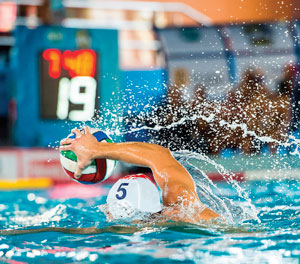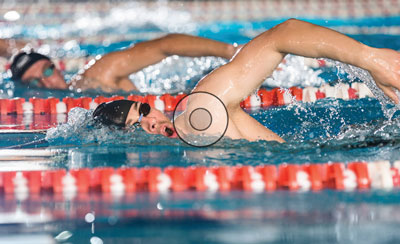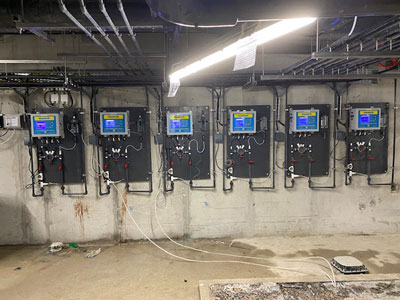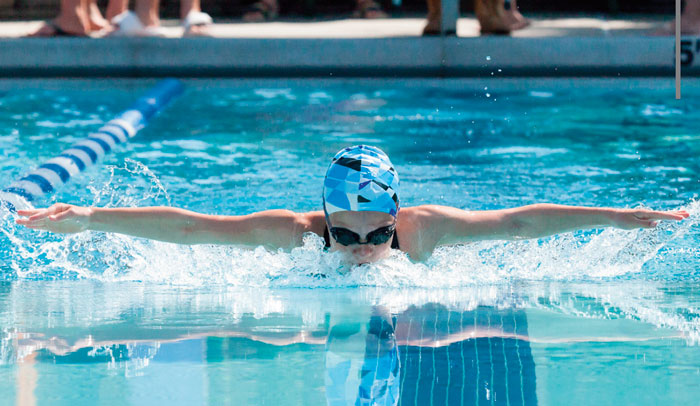Aquatic facilities’ air and water quality are crucial to keeping everyone in the building safe and extending the lifespan of the actual facility and the equipment within the facility.
The two are linked, and inattention to either can ruin the attention paid to the other, said Juliene Hefter, executive director and CEO of the Association of Aquatic Professionals. Water quality gets the most attention from nonprofessionals because it’s what they swim in, but a facility’s HVAC system plays a major role in enhancing the experience.
“Air quality can affect many things within an indoor aquatic facility,” Hefter said. “Poor air quality can be caused by a lack of air circulation and chemical reactions within the water. Poor air quality can affect the health of staff and patrons, and, surprisingly, can affect the pool equipment itself.”
Keeping the pH, alkalinity and chlorine within the appropriate ranges and maintaining a high enough oxidation reduction

potential (ORP) assists with air and water quality, said Hefter. At any given time, facility managers want to make sure that they are killing off all of the nitrogen that is introduced into the water by patrons and other incidents. Proper air circulation in an indoor facility also helps with accomplishing this.
“When nitrogen gets introduced into the water, the chlorine/disinfectant is there to kill off the bugs and germs,” she said. “In addition to that, we need our ORP levels at a minimum of 650 for instantaneous bug kill. If our chlorine is not able to keep up with the demand, chloramines are formed and take away from the chlorine’s ability to disinfect and sanitize the water.”
Ensuring that water is free from combined chlorines and has a high ORP assists with the water quality and air quality, Hefter said. Water quality also includes keeping the water within the swimming pool balanced. Balanced water extends the lifespan of the aquatic facility as a whole.
Hefter said that unless a pool operator has some formal training such as AFO, CPO, PPM+, Aqua Tech, etc., they may not know what issues can arise with their air and water quality.
For example:
- A facility does not have enough air circulation. “When this happens, it is difficult, if not impossible, to eliminate chloramines within the water,” Hefter said. “They must then be creative and come up with options to increase the airflow to super-chlorinate, burn off the chloramines and eliminate them. Purchasing large fans that they turn on when they are super-chlorinating and opening up any outside doors to push the bad air out assists with this.”
- Constantly adjusting controllers as they do not feel that they are correct. “The less hands on the controllers the better,” said Hefter. “Once they are set properly, operators should leave them unless there becomes a problem with the system not keeping up with demand.”
- Equipment not large enough to keep up with demand on the busiest days. Hefter suggests getting larger pumps that can keep up with the demand.
- Not making sure that the chemical treatment system is set to work with their source water. “Ensuring that the correct sanitizer/disinfectant is used along with the correct pH adjuster makes it much easier to keep chemicals within the correct ranges, keeps swimmers safe, and saves money on the use of additional chemicals,” Hefter said.
Technology and innovation have kept up with facility and swimmer demand over the years, helping stakeholders establish and maintain good air and water quality. Joshua Ptak, aquatics director for Elkhart Health & Aquatics, Beacon Health & Fitness, in Elkhart, Ind., has managed several facilities of all types this century. His current facility houses a 68-meter by 25-meter main competition pool with bulkheads to subdivide the pool, including a diving area with 1-meter springboards, 3-meter springboards and a 3-meter and 5-meter platform. It also has a 4-lane 25-yard instructional pool, warm-water therapeutic pool and whirlpool.
Ptak said technology has been a game-changer in how pools are maintained. “From the pool-water standpoint, I can see

where any of the 10 pools I manage are at on a water chemistry level both on the chemical controller and staff chemistry logbook directly on my phone, iPad and laptop,” he said.
“Not only that, but I can also get a text when any pool system goes into an alarm. Our entire HVAC system and pool system are similar where the technicians who we have both scheduled and on-call 24/7 get a notification the minute something goes into an alarm. It gets you the details as to what part of the system is in alarm and how critical it may be—is the system completely down, or is it just going to be a little more humid until someone has their hands on it?”
Ptak said that if he had an unlimited budget, he would have an oversized dehumidification system as well as exhaust and supply fans to be able to do a complete override, including low air returns and large fans above the pools.
“The ability to do exchanges of air rapidly for the space is huge,” Ptak said. “Also oversizing UV (ultraviolet) for the pools themselves. At a minimum, the ability to have turnover of the air with the dehumidification and have appropriate UV on the pools—wanting to keep that 40% to 60% RH (relative humidity) in the space and combined chlorine levels at a 0.0-0.5 ppm.”
Because equipment for pools takes up a lot of space, Ptak reminds managers of new construction to plan for what they need and add some extra room to maintain as well as store essentials such as chemicals, parts and supplies. “Think about the day-to-day when designing and building, then think of the worst-case scenario,” he said. “Factor in growth for the future as well. Add something like solar to help the energy consumption that pools have for running 24/7.”
Ptak said even the latest technology needs the help of human touch. It is very important that a hands-on approach is maintained and that all aspects of the systems have eyes on them regularly, he said.
“Water chemistry is checked multiple times per day to maintain pool water balance as well as immediate investigation into anything that looks or sounds off,” he said. “You always look at the detail, how the flow of activity each day may or may not affect your air and water quality. A swim meet is going to have a different outcome on our facility compared to a day full of swim lessons and swim practices. It is knowing and understanding how one decision could affect another and being well-positioned and prepared to resolve issues in a timely manner.”
The training of staff is a major aspect of that people power, Ptak said, but said that holding a certification and having hands-on experience and training are very different things.
“Our team has a mix of PHTA (Pool and Hot Tub Alliance) certified pool operators and HVAC technicians as well as our day-to-day lifeguards, swim instructors and coaches,” Ptak said. “It is important that the staff not only holds appropriate certifications for their roles, but also have an understanding of the facility and communicate when something doesn’t seem to be right. Lifeguards are checking the water chemistry three to four times per day plus cleaning; facility technicians are checking pool chemistry another two to three times per day, plus all the other pool mechanics in the back. Our HVAC team routinely are checking belts, filters, compressors and fans to ensure that units are running to the best of their ability and keeping a good log of what has been maintained.”
Air quality derives from water quality, and water quality begins with chemical treatment of the water to ensure germ-killing and balance of chlorine residual and pH, said Samantha Greig, a chemist with a pool chemical manufacturer and supplier based in Pittsburgh, Pa.
Most facilities prefer chlorinating with either liquid bleach or calcium hypochlorite, which is in granular or tablet form. Each has its own disbursement system. Greig said the type of facility—waterpark or competitive or recreational—isn’t important. “What matters is the sizing of the chlorination system used,” she said. “If it is liquid bleach, then the facility must ensure that enough bleach is on-site to chlorinate each body of water in between bleach deliveries. This might be 15- or 50-gallon drums, or larger on-site containers of bleach that are filled by tanker trucks.
“If calcium hypochlorite is used, then the size of the chlorinator is important. Cal-hypo feeders come in a large variety of sizes—some small enough to chlorinate a splash pad and some large enough to chlorinate millions of gallons of water. Of course, multiple chlorinators can be used in tandem on a single body of water if necessary.”
She said before operators call for help from a manufacturer, they should consider:
- What is the facility and each body of water used for? Therapy pool? Kiddie pool? Exercise?
- What is their air handling protocol? How much air is moved/conditioned/replaced?
- Are they removing air from the water’s surface?
- Size of each of the bodies of water that need sanitation, in gallons.
- Bather load per day.
- Water replacement strategy (if one exists).
- Current chlorine and pH adjustment chemicals/systems.
- How much of each chemical (other water balance chemicals, as well) is added each day, along with water balance records.
The equipment provider perspective involves the transmission of the chemicals and the regulation of that transmission.

The rise of ultraviolet (UV) sanitizing and salt chlorine systems (chlorine made on-site) has added to the traditional media and regulation methods, said Mike Fowler, commercial sales manager of a Florida-based provider of pool equipment.
Fowler said operators need to know several things about their location when considering equipment purchases. First, they should “always check with their local jurisdiction to find out what their requirements are for chemical levels, especially when it comes to sizing a salt chlorine system, to see what they want to see for that particular aquatic center,” Fowler said. “When asking for us to help size a pump and filter for new install or replacements, we want to make sure they know the size of the pool and hopefully what the total dynamic head (TDH) is in their system, so pumps and filters can be sized correctly for the given turnover rate. This also would help in the proper selection of a UV system for those indoor facilities especially, where chloramines are such an issue.”
Fowler said automation and UV systems are the technologies that have made the greatest advances to improve water quality. “Automation has addressed water quality by improving sensor responsiveness and control algorithms to prevent chemical level fluctuations due to either bather loads or environmental influences,” he said. “In the past, UV systems were expensive and complex which was a significant barrier to many indoor pools, but improved UV lamps removed those barriers.”
Automation is not a cure-all, stressed Brett D. Steinbrueck of a controller manufacturer based in St. Louis. As Ptak said, humans must work together with machines to maximize air and water quality.
“Facilities should have somebody on staff that is knowledgeable and responsible for maintaining proper water chemistry,” Steinbrueck said. “Installing a water chemistry controller is not an install-it-and-forget-it solution; a water chemistry controller is a tool that will respond to changes in water chemistry faster than any person could. Like any other tool, it can do a great job in the hands of a skilled operator.”
Steinbrueck said that very marriage of people and equipment is one of the ongoing challenges. While humans are more likely to err by hand-feeding chemicals, they are more prone to emotions when considering controller technology.
“One of the biggest challenges is a general reluctance to automation,” he said. “Many feel intimidated by a new piece of equipment that automates a manual activity, like feeding chemicals or backwashing filters. But trying to do everything manually requires continual training, especially when there is significant staff turnover. That in itself can be fairly complicated, and difficult to manage.”
It’s a good sign that companies that provide equipment for managing air and water quality will refer to user and staff health when asked about the ROI of their products, as more than one did for this story. Steinbrueck said investment recovery can be sold as what it gives as much as what it saves.
“The primary focus should be on providing healthy and safe water for visitors,” he said. “It only takes one event, and the associated bad press or negative social media chatter, to give a facility a bad reputation that is very difficult to overcome. Implementing a program to ensure proper water chemistry, including a reliable water chemistry controller, is a proactive and responsible way to help prevent such situations. ROI can typically be justified through associated chemical savings, but this should not be the compelling reason for adding a water chemistry controller.”
There is a dollar impact to controllers though, obviously, said Dave Button, vice president of business development for a California-based provider of water treatment automation. “A chemical controller adds chemicals when the body of water needs the chemicals,” he added. “When you hand-feed, it is common to overfeed chemicals to make it last until you can hand-feed again. A chemical controller will also help extend the life of other equipment, which will save the facility money. It reduces labor because they do not need to have staff adding chemicals to balance the water.”
Wesley G. King, owner and founder of Wesley King Consulting, said one way to maximize ROI is to remember to let folks know about any new water or air quality feature you add. “Create meaningful messaging about how much better the air will be with the new special HVAC unit, for example,” he said. “Showcase to your pool users the true outcomes that will be achieved, like less closing, future health inspections met, etc.”
One pool manufacturer has a unique way to address chloramines, though it can only be used if the entire pool is installed as the method is integrated into the whole structure, said Katy Houston, director of project development and engineering for a Florida-based builder of swimming pools. Houston said the system is the only product on the market that actively strips chloramines out of the gutter and exhausts them via suction conduit built into the structure. She said it’s a much more efficient way to remove chloramines vs. a system that tries to exhaust and turn over all the air in the natatorium.
“The system strips out the
chloramines from its source and immediately exhausts the air instead of waiting for the chloramines to aspirate to the air space,” she said, “therefore a much more concentrated/smaller volume of air is needed for exhaust. Additionally, the introduction of any system to address chloramines in the natatorium will positively impact the longevity of the facility as it reduces the presence of those corrosive compounds.”
Not to be overlooked are the larger contaminants in the water that also use both human and machine to keep pools clean. Vacuuming is very much a part of the air and water quality equation, said Matthew Chilton, director of marketing for a New Jersey-based provider of pool vacuums. “The innovations in battery-operated, cordless pool vacs and robotic pool cleaners make it easy and fast for staff to keep pool surfaces free of debris as well as algae and other organic and inorganic byproducts that can be both unsightly and unhealthy,” Chilton said. “In the past, many of these technologies were out of the price range of some aquatic facilities. But today’s new technologies are available from a wide range of suppliers with offerings for just about every budget.”
Willa Suter, the safety and compliance specialist for the aquatics and athletic facilities division of the department of parks and recreation for Prince George’s County in Maryland, said regardless of equipment and training, teamwork continues to make the air and water quality dream work.
“Typically for water chemistry we rely on having nationally certified operators running the pool, and air quality is maintained by HVAC trade professionals,” she said. “In smaller agencies the pool manager or most senior aquatics staff member may also have to learn the air quality systems. Working together with all involved people is key to building a strong understanding and appreciation for what goes into each of these areas and how they can rapidly impact one another.” RM



